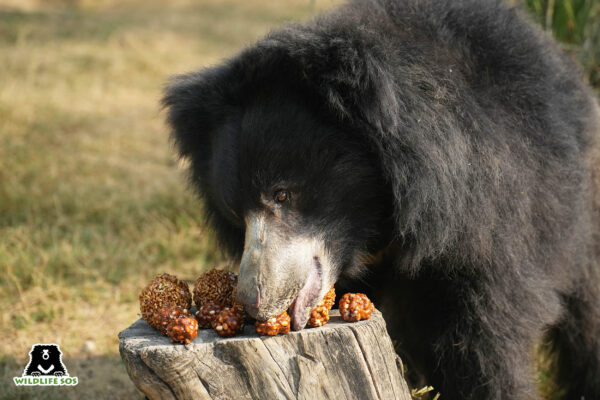Base Line Survey reveals elusive Himalayan Brown Bears’ diet even contained biryani and chocolate wrapperI
ISHFAQ TANTRY
SRINAGAR, DECEMBER 21, 2022
Kashmir’s largest mammal, Himalayan Brown bear, like its American counterpart, has been found to raid garbage dumps in residential areas in search of food.
A baseline survey on the region’s brown bears conducted by India’s Wildlife SOS in collaboration with the Wildlife Department of Indian Jammu and Kashmir has found that the bears consume food from garbage dumps, including plastic carry bags , milk powder, biryani and chocolate wrappers as they venture into lower altitudes in search of food.
This behaviour of the Kashmir’s Brown bear is akin to its counterpart in YellowStone National Park in United States, which also feed themselves by raiding garbage dumps.
The findings of the report are ground-breaking, revealing not only pivotal details about the Himalayan Brown bear but also about the plight of Kashmir’s largest mammal.
“Due to the remote terrains they occupied, the Himalayan Brown bear was a rare sight for the last two decades. Recently, however, the Brown bears have increasingly come into the purview of humans as they venture into lower altitudes in search of food The most riveting and desolating finding in the report has been that much like their counterpart in YellowStone National Park, the Himalayan Brown bears too are raiding garbage, and are rapidly becoming accustomed to this”, the report says.
The Wildlife SOS team conducted an in-depth diet analysis of the Brown bear. This was done by studying scats of 408 Brown bears, the results of which revealed that 86 bears have excreted plastic carry bags, milk powder, and chocolate covers in their scats. “Some scats even had remnants of glass! As much as 75% of all that Brown bears consume comes from garbage, which means that their frequency to scavenge garbage is much higher than eating wild plant matter, crops, and even hunted sheep”, reveals the report published by the Wildlife SOS..
It added: “The findings from scat analysis were strengthened by data gathered from camera traps. Out of the 20,627 camera trap footage, 9,131 footage captured bone-chilling sequences of Brown bears foraging for food at garbage dumps. Their natural diet of fresh plants, insects and small mammals has been replaced by improperly disposed high-calorie foods, like the famous Indian Biryani!”
Camera trap results
Camera trapping is widely recognized as a very effective tool in the investigation of presence, morphology, behaviour, and movements of individuals and populations of animals.
“ The entire study area was divided into 27 grids (5x5km) and the trapping was conducted in 16 grids .Camera trap sampling was carried out from 8th July 2021 to 28th Oct 2021 for 112 days with a sampling range of 10 to 59 days at each site.The species recorded were Himalayan brown bear, Red fox, Yellow-throated marten, Marmot, Jackal, Ibex and domestic animals such as horse, cattle and stray dogs”, the report says.
“Tourists were photo captured in the Thajwas location (in Sonamarg area) alone. Species composition varied with sites, brown bear was recorded in five sites, with maximum capture in the Sarbal, Army camp and Amarnath. Jackal were also found scavenge along with bears in the Sarbal area. A Yellow-throated Marten was recorded in the Nichnai site”, the report adds, while also sharing details of other wildlife which were recorded in the camera trappings..
Diet composition of Brown bear
The research team of the Wildlife SOS used the scat analysis method to study the feeding ecology of brown bears in the study area as this method provides reliable estimates of food items consumed by the brown bears.
“The scat analysis revealed that brown bears in the area fed upon vegetative materials, fleshy fruits and minimal animal matters. Brown bears are opportunistic omnivores, their diets comprised of fruits, other plant materials, and animal items such as mammals, fishes and insects. The major food items of brown bear were grouped into variety of ways based on taxonomic group and method of acquisition.
The analysis of total 408 scats, showed both plant and animal matter in the diet of brown bear scats. Plant and animal matters were considered to know their contribution to the diet, but it was found that the frequency of occurrence of garbage food items (75%) was higher in the cats of brown bear than the wild plant matter (16%), crop raid (0.41%) and sheep hunting (0.31%) respectively (Fig. 7)”, the study revealed.
Bears are noncecal monogastric and do not digest fiber efficiently, so highly digestible high calorie food are essential to their diet. As it has been reported that Grizzly bear in the Yellowstone National Park were heavily dependent on garbage dumps ,thus scavenging in the garbage site could be attributed to the proximate factors such as food availability, palatability, habitat degradation and ultimate factors nutrient requirements and increase in the body mass, the report states.
Putting cap on pilgrim flow to annual pilgrimage to the Himalayan Cave:
The research team during its study also observed the brown bears were visiting the Amarnath – a Himalayan cave shrine thronged by the Indian Hindu pilgrims in summers – garbage sites during day hours also. “Most of the bears seems to have forgotten their original feeding behaviour and these kind of garbage sites were very attractive as easy foraging ground and lead to food habituation”, the report reveals adding that “ it is a serious concern as such behaviours if passed to next generation could lead to changes in feeding behaviour with young ones considering it as their natural behaviours and lead to conflicting situation in the future.”
One of the surprising finding in the study was that not only bears but other animals like marmots and the elusive Asiatic Ibex were regular visitors and marmots especially were highly habituated taking food from even pilgrims’ hand also.
“This elusive species has been a challenge to work with, but our team’s efforts along with tremendous help from the J&K Wildlife Protection Department have yielded great results”, Wildlife SOS Co-founders Geeta Seshamani and Kartick Satyanarayan stated. “This project dives into gathering a comprehensive understanding of what is affecting these critically endangered bears in a manner that has not been done before. We hope to make real progress and eventually help with the reduction of human-bear conflict in the area”.
Stating that Wildlife SOS team “has successfully conducted an extensive survey in the area in a very short span of time, using camera traps”, the Regional Wildlife Warden, Kashmir Rashid Yahya Naqash said he hoped the study is helpful in determining people’s perceptions believing in conservation through coexistence. “Based on these findings a set of results and recommendations have been produced in the form of this report”, he added.
The key recommendations of the report include:
The report further notes that the main factors that bring humans and brown bear into situations of increasing confrontation in and around Thajiwas Sanctuary are:
-Expansion of developmental activities corresponding to tourism and holy pilgrimage
activities into brown bear prime habitat leading to habitat fragmentation and
destruction.
-Loss of corridors and blocking of traditional migratory routes leading to change of
movement pattern and confrontation.
-Food habituation due to presence of sufficient easy food at open food dumping and
Garbage sites.
-Huge presence of migratory livestock and shepherds for 3-4 months during summer and Autumn season in the brown bear habitat is one of the major causes of disturbance and as a result conflict
Presenting the management recommendations to the Amarnath Ji Shrine Board
while keeping in view the safety of local people and Pilgrims, the report says that it is important to consider its recommendations in order to ensure the minimization of current and the future brown bear-Human conflict situations.
The researchers while advocating regularisation of the pilgrim to the Amarnath Cav have said that “limitation should be imposed based on the carrying capacity of the land scape to avoid future conflict”.
“Both the Domail to Amarnath (16 km) and Chandanwadi to Amarnath (36 km) holy routes are leading in brown bear and snow leopard habitats. A tunnel route can be proposed from Baltal/Zojilla to Amarnath (7.59km) to avoid human pressure on the wildlife corridors”.




